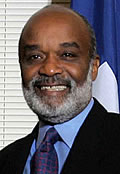U.S.: The Biggest Foreign Investment Patron In Haiti
< Previous | Home | Next >
EXAMPLE SET BY U.S. INVESTMENT: NO CONTRACT
Writing in 1992 the U.S. Commerce Department stated that, "The United States is by far the largest foreign investor with an estimated $120 million [$90 million excluding inventory] invested in Haiti as of early 1991. With the exception of several oil companies and banks (Texaco, Exxon, Bank of Boston, Citibank), U.S. investment is almost entirely in the assembly sector."73 U.S. investment is estimated to represent over 90 percent of total foreign investment in Haiti.
Also, 95 percent of Haiti's light manufacturing exports are destined for the U.S. markets.
What have been the social results accompanying this U.S. investment?
In 1982, the U.S. Labor Department observed that, "There is a long history of government repression of the labor movement in Haiti." Not surprisingly then, "The organized labor movement in Haiti is almost non-existent." However, "investment and assembly-type opportunities in Haiti are excellent because of Haiti's low labor costs."
If we leap ahead to 1990, the U.S. Labor Department is still convinced that "dexterous, low-cost unskilled labor [all] remain selling points for labor-intensive assembly operations in Haiti".
Nor has the labor rights situation changed all that much. According to the Labor Department's 1990 report "Worker Rights in Export Processing Zones":
It appears that while freedom of association, the right to strike, and to organize are legally provided to all workers in Haiti, in reality few workers enjoy such rights whether employed in export processing operations or local firms.
74
To the Labor Department, "it appears that many employees of the export industry are not in fact willing to bargain with trade unions." Also, "many employers, domestic and foreign, still question the legitimacy of unions."75 In fact, there is not one single collective bargaining agreement in effect in Haiti's assembly sector.
Once again, what happened to the progressive element of the private sector that USAID was nurturing?
During the 1980's USAID spent millions to promote foreign investment in Haiti's assembly sector, while the continuing violation of internationally recognized worker rights in the export processing zones remained nearly untouched.
Given that USAID was working with U.S. companies and U.S. Haitian joint ventures, the job of promoting worker rights should not have been insurmountable.
Roopy, July 18 2010, 3:20 PM
Start a NEW topic or,
Jump to
previous | Next Topic >
< Previous | Home | Next >
< Previous | Home | Next >

 Bill Clinton in Haiti Palais National
Bill Clinton in Haiti Palais National  Rene Preval Making a speech
Rene Preval Making a speech  Rene Preval and Georges W. Bush
Rene Preval and Georges W. Bush  Rene Preval and Jean-Louis Debre
Rene Preval and Jean-Louis Debre  Rene Preval and Hugo Chavez
Rene Preval and Hugo Chavez  Rene Preval in Canada
Rene Preval in Canada  Rene Preval and Peter MacKay
Rene Preval and Peter MacKay  Rene Preval and Dominique de Villepin
Rene Preval and Dominique de Villepin  Rene Preval and Stephen Harper, Canada Prime Minister
Rene Preval and Stephen Harper, Canada Prime Minister  President Rene Preval
President Rene Preval  President Rene Preval speaks to Al Jazeera about the reconstruction of...
President Rene Preval speaks to Al Jazeera about the reconstruction of...  Discour President Rene Preval Aux Gonaives 1er Janvier 2009
Discour President Rene Preval Aux Gonaives 1er Janvier 2009  Secretary Clinton Remarks With President Preval Of Haiti
Secretary Clinton Remarks With President Preval Of Haiti  Obama Dissed Preval In Trinidad Preval Pawol Tafia
Obama Dissed Preval In Trinidad Preval Pawol Tafia  Bringthepai Preval Kout Soulye
Bringthepai Preval Kout Soulye 

